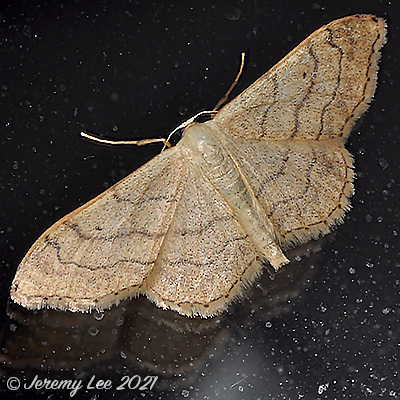
 |
|
Scientific Classifications explained » Amphibians » Ants » Aphids » Bees » Beetles » Birds » Bugs » Butterflies » Caterpillars » Damselflies » Dragonflies » Earwigs » Flies » Frog/Leafhoppers » Fungi » Galls » Grasshoppers » Harvestmen » Hoverflies » Lacewings » Ladybirds » Leaf Mines » Lichens » Mammals » Millipedes » Mosses » Moths » Sawflies » Slugs » Snails » Spiders » Trees & Shrubs » Wasps » Wild Flowers » Woodlice » Postboxes |
UK Nature > Moths > Idaea aversata

Scientific Name: Idaea aversata Common Name: Riband Wave Idaea aversata, more commonly known as the Riband Wave, has a wingspan of 30-35 mm; adults are generally a reddish or greyish colour with three distinctive median cross lines on the forewings and two on the hindwings. The banded form has a well-defined darkish broad band across all wings. Distinguished from the Plain Wave (Idaea straminata) by the absence of the discal spots, its larger size and the shape of the sub-terminal line which is straight rather than indented. Widespread and commonly recorded in southern counties. Less frequent further north. On the wing from the beginning of June to the end of August. Commonly encountered in a wide variety of habitats. Adults appear frequently at light in moderate numbers. The larvae can be found from September to May on a variety of low-growing plants such as Bedstraw (Galium sp.), Knotgrass (Polygonum aviculare), Dock (Rumex) and Dandelion (Taraxacum). Overwinters as a larva. |
|

https://www.uknature.co.uk is a website dedicated to showing the immense diversity of UK nature and wildlife. Our vast range of habitats, from lowland arable to snow covered mountains, from storm-ravaged coastlines to peaceful inland freshwater lakes and rivers, from dry, sandy heaths to deciduous and coniferous forests, all these habitats contribute to the abundance of UK nature. We have wild birds in huge numbers either residing or visiting our shores (597 recorded species as at July 2013) and we must also not forget the humble back garden with its grass lawns, flower beds filled with nectar rich flowers, shrubs and trees, all designed to attract huge numbers of insects such as bees, moths, butterflies and hoverflies; and finally the small ponds which provide safe havens for frogs, toads, newts and even slow worms and grass snakes. www.uknature.co.uk is the showcase for my personal passion, photographing uknature in all its glory. I sincerely hope you all enjoy the fruits of my labours. This site and all images contained therein is © Jeremy Lee 2004 - 2025. All Rights Reserved. Site design by Jeremy Lee. Site development & IT Support by Stuart Lee. |